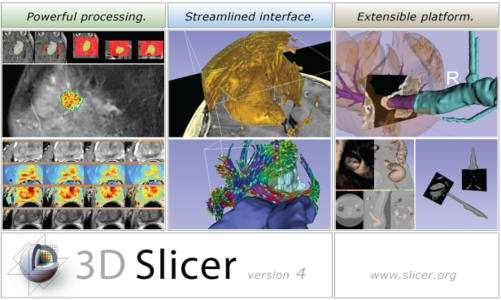|
|
| Line 2: |
Line 2: |
| | | | |
| | {{documentation/{{documentation/version}}/Developers/random-image}} | | {{documentation/{{documentation/version}}/Developers/random-image}} |
| − |
| |
| − | 3D Slicer is a free [http://en.wikipedia.org/wiki/Open_source open source] extensible software application for medical image computing and visualization. Mainly written in [http://en.wikipedia.org/wiki/C%2B%2B C++] and based on the [http://www.na-mic.org/Wiki/index.php/NA-MIC-Kit NA-MIC kit], 3D Slicer relies on a variety of libraries: [http://www.vtk.org VTK], [http://itk.org ITK], [http://commontk.org CTK], [http://www.cmake.org CMake], [http://qt.nokia.com/products/ Qt] and [http://www.python.org/ Python].
| |
| − |
| |
| − | To ensure the stability of the application, relying on a robust [http://www.kitware.com/solutions/softwareprocess/softwareprocess.html software process], the source code is compiled and tested on a daily basis on a [[Documentation/{{documentation/version}}/SlicerApplication/HardwareConfiguration|variety of platform configurations]]. The testing results are summarized and reported using a web-based centralized CDash [http://slicer.cdash.org/index.php?project=Slicer4 dashboard]. Developers of 3D Slicer can also report issues on the [http://massmail.bwh.harvard.edu/mailman/listinfo/slicer-devel open mailing list] or using the [http://na-mic.org/Mantis/my_view_page.php web-based bug tracking system].
| |
| − |
| |
| − | 3D Slicer consists of both a lean application core and modules offering specific functionality. The core implements the user interface, provides support for data input/output (IO) and visualization and also exposes developer interfaces that support extension of the application with new modules.
| |
| − |
| |
| − | Three types of modules are supported: [[{{FULLPAGENAME}}/Modules#Command_Line_Interface_.28CLI.29|CLI]], [[{{FULLPAGENAME}}/Modules#Loadable_Modules|Loadable module]] and [[{{FULLPAGENAME}}/Modules#Scripted_Modules|Scripted module]]. While the developer has to choose between one of the 3 types to implement its module, the end user won't notice the difference as they all share the same look & feel. The choice for a given type of module is usually based on the type of inputs/parameters for a given module.
| |
| − |
| |
| − | These modules can be either built-in or installed on demand via the [[Documentation/{{documentation/version}}/SlicerApplication/ExtensionsManager|extensions manager]].
| |
| − |
| |
| − | = Add or improve a functionality: Where to start ? =
| |
| − |
| |
| − | [[File:SlicerDeveloper-ContributionWorkflow.png | 1100px]]
| |
| | | | |
| | = Developer references = | | = Developer references = |
| Line 63: |
Line 49: |
| | |bgcolor="#CCCCCC"| | | |bgcolor="#CCCCCC"| |
| | |valign="top"| | | |valign="top"| |
| − |
| |
| − | === Step by step - Develop a module or an extension ===
| |
| − | ----
| |
| − |
| |
| − | # [[#Add_or_improve_a_functionality:_Where_to_start_.3F|Where to start?]]
| |
| − | # [[{{FULLPAGENAME}}/Build_Instructions|Build Slicer application]]
| |
| − | # Create
| |
| − | #: [[{{FULLPAGENAME}}/Modules#Command_Line_Interface_.28CLI.29|CLI module]]
| |
| − | #: [[{{FULLPAGENAME}}/Tutorials/ModuleWriting|Loadable module]]
| |
| − | #: [[{{FULLPAGENAME}}/Modules#Scripted_Modules|Scripted module]]
| |
| − | #: [[{{FULLPAGENAME}}/EditorExtension|Editor effect]]
| |
| − | # [[{{FULLPAGENAME}}/Tutorials/BundleModulesIntoExtension|Bundle your module(s) into a Slicer extension]]
| |
| − | # [https://github.com/jcfr/ExtensionsIndex/tree/24-ExtensionIndex-add-readme-file#readme Build, test, package and distribute extensions]
| |
| | | | |
| | === Build instructions === | | === Build instructions === |

